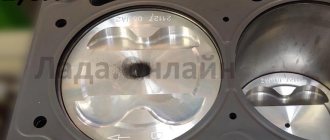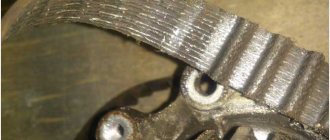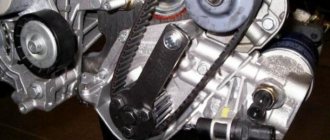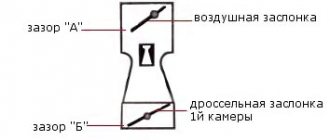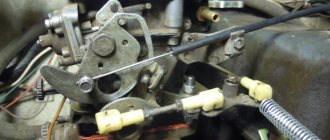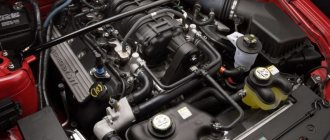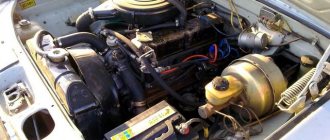Appearing on the domestic market in 1984, the legendary G8 immediately won an army of fans. The model became not only an excellent family car, but also acquired the status of a youth hatchback. For a long time, the car was in service with many sports clubs.
The model came off the assembly line only in 2003, almost 20 years after its appearance. During this period, completely different power units were installed on the car. One of them was the VAZ 21083 engine.
The engine was specially created for a transverse arrangement. This is due to the front-wheel drive "eight". Until now, many car enthusiasts are interested in the features of the engine, its shortcomings and capabilities.
Specifications
Thanks to the hatchback's low weight (915 kg) and short length (4006 mm), it could be accelerated by almost any engine of its time. Engine 21083 has the following technical characteristics:
- volume - 1.5 liters;
- cast iron cylinder blocks;
- in-line engine type;
- The power supply system is represented by a carburetor;
- piston stroke is 71 mm;
- power - 73 hp;
- 4 cylinders (2 valves each);
AI93 fuel is suitable for engine 21083. The engine consumes 7.9 liters in the city, 7 liters on the highway. For every 1000 km, 50 g of oil is consumed. The following oils should be poured into the engine:
- 5W-30;
- 5W-40;
- 10W-40;
- 15W40.
According to factory data, the resource of the unit is 125 thousand km. In reality, it can reach 250 thousand km. The predecessor of the unit is a 1.3 liter engine.
The engine's capabilities are quite wide. Without losing engine life, you can increase power to 90 hp. If you “squeeze” all the potential out of the engine, the power can be increased to 180 hp. The 1.5 liter engine has a modification with an injector. This unit operates in conjunction with a 5-speed gearbox.
The 1.5 linjector engine has a power of 78 hp. at 5400 rpm. The use of an engine with direct injection made it possible to improve the dynamic characteristics of the car, as well as improve efficiency. In addition, the amount of harmful emissions has significantly decreased.
General information
Engines of the VAZ-21081 (1100 cc), 2108 (1300 cc) and 21083 (1500 cc) models were developed specifically for the new family. In the first years, the cars were equipped with engines with an engine capacity of 1100 and 1300 cc. see. The first 54-horsepower version was exported; such cars were almost never sold within the USSR. The bulk of cars for the domestic market were equipped with a 64-horsepower engine.
All engines of the family have a high degree of unification. The differences are only in cylinder blocks (three types, have different diameters and block heights), block heads (two types, with different sections of gas channels), pistons (two types, with a diameter of 82 and 76 mm) and crankshafts (two types, elbows under different piston stroke).
The development of the most powerful 72-horsepower version of the 21083 engine dragged on for several years. But it was this option that was destined to become a long-liver and last in a modernized form on the assembly line until the present day. The 87-horsepower engine with a cylinder capacity of 1.6 liters, widely used in the products of the Volzhsky Automobile Plant, is based on the 21083 engine.
Engine Features
VAZ 21083 (carburetor) has several characteristic features that are important for the owner of a V8 to know. Description of some engine features:
- It is worth refusing to use low-octane fuel for this model. This negatively affects the operation of the carburetor. Initially, the engine was created for 93 gasoline.
- The wad is located on top, which allows you to get rid of inertial moments.
- The engine has a belt drive - the car owner should change the guide rollers and the belt itself every 50 thousand km.
- In this series of units, the piston diameter was increased to 82 mm.
- The reliability of the motor is explained by its design. If the drive belt breaks, the moving pistons do not collide with the valves. This also makes it easier to overhaul the engine.
In addition, the unit is lightweight and economical. Such features appealed to many domestic car enthusiasts. The injector provides more economical fuel consumption, as well as ease of starting the engine in any weather conditions.
If the injector is clogged, detonation combustion of the fuel mixture is possible, which can result in engine damage.
What most often breaks down in an engine?
Considering that the engines described above, when used correctly, have a long service life before the first major overhaul - up to 250,000 kilometers - most often they fail due to breakdowns of attachments.
For example, if the engine stalls, this most likely indicates a malfunction in the ignition system, and not a breakdown in the connecting rod and piston group. A similar problem occurs quite often. If the engine is misfiring, that is, any cylinder does not work, the breakdown must be repaired as follows.
- First you need to put on rubber insulating gloves or prepare pliers with dielectric pads on the handles.
- Then you need to remove the caps of the high-voltage wires from all the spark plugs one by one. When removing the cap from the spark plug of an idle cylinder, the engine will not stall. In other cases it will definitely stall.
- The faulty spark plug needs to be unscrewed and a new, working one screwed in its place. If after this the engine stops running, it means that the repair of the VAZ engine is completed. If the cylinder does not work, then look at the next point.
- It is necessary to replace the high-voltage wire coming from the ignition distributor to the spark plug of the inoperative cylinder.
- If the engine still runs rough after this, replace the ignition distributor cap. Everything should now work.
Return to contents
Flaws
It is worth paying attention to several serious shortcomings of the unit. One of the problem areas is the oil filter, which often leaks. Running dry has a negative impact on the condition of the unit.
A common malfunction is the malfunction of the distributor sensor. Fuel pumps often fail. The carburetor is also the weak point of the unit. This is especially true for the first models.
The quality of the fuel mixture for internal combustion engine 21083 should be quite high. If for the first modifications of VAZ cars it was possible to use 76 gasoline, then in the case of s21083 it can quickly fail.
Cylinder block
The cylinder block of the 21083 engine is made of cast iron and has a cylinder diameter of 82 mm. At the factory, the part was painted in a characteristic blue color. The block design allows for boring and honing of cylinder mirrors to repair dimensions. Inside the block body there are lines for supplying lubricant to the bearings of the crankshaft and camshaft.
An oil filter and a fitting for the crankcase gas pumping pipeline are installed on the cylinder block. The fitting has space for installing an optional oil level sensor. The block has bosses for mounting the generator and front engine mount. The clutch housing is attached to the rear of the block.
For uniform cooling, the coolant channel is made along the entire height of the cylinder. There is no fluid flow between the cylinders. These channels are directly connected to a centrifugal pump installed on the front of the unit. The upper part of the channels is open and joins with similar channels in the block head.
Tuning
For car enthusiasts who own a V8 (carburetor, injector), it is important to know what the tuning power unit is capable of when properly equipped. The optimal and simplest way to boost the engine is to replace the camshaft with an OKB Dinamika one. The output will be about 80 hp.
If you modify the intake manifold and cylinder head, as well as the milling of the cylinder head and valves, you can get 85-90 hp. An increase in power in the future is possible by increasing the engine volume to 1.6 liters. This is accomplished by mounting a crankshaft with a 74.8 mm stroke. In this case, you can get all 95 hp.
If you use valves with a larger diameter and also use lightweight valve plates, you can squeeze up to 110 hp out of the engine. Such VAZ engine tuning can satisfy many car owners.
You can also install a compressor to increase the power of the unit. It is better to switch to injection injection. However, you can also install a compressor with a carburetor. It is possible to increase the power characteristics without a turbine up to 150 hp, but the engine life will be significantly reduced.
In addition, in the city the car will behave too “aggressively”. The best option is to install a 16-valve cylinder head. If you use a typical city kit (receiver with exhaust on a 51 mm pipe, 54 or 56 mm throttle body), you can easily get 105-110 hp without losing resource.
Some car owners install a carburetor from a VAZ 21083 on a UAZ to reduce fuel consumption. However, it is better not to use this option - consumption practically does not drop, and traction decreases.
PP lever shakes at idle
Is the handle jerking? Check the engine mounts
A jerky shift lever at idle is a fairly common occurrence if your car is old. Few people associate this problem with the power unit, but in vain. This symptom indicates excessive wear of the engine mounting pads. And if the problem is not eliminated, the engine will sag, and other complications will appear - difficult gear shifting, severe shaking of the front of the car when driving and increased wear of constant velocity joints (CV joints). As a result, CV joints will have to be changed every 5,000 kilometers.
Procedure for replacing engine mounts on a VAZ 21099.
- We place the car on the inspection hole, put chocks under the wheels, and put the car on the handbrake.
- Disconnect ground from the battery.
- Open the hood all the way up.
- Remove the crankcase protection.
- We hang the power unit and gearbox on hoists and slightly pull them up.
- Unscrew the bolts securing the central front support.
- We remove the old support, tighten the hoist a little, and mark its top with a marker. This is necessary for proper installation of the new support.
- We mount a new support, attach its bolts, tighten them, but do not tighten them completely.
- We remove the starter.
- Unscrew the bolts securing the left pillow and remove it.
- Installing a new left pillow. We also tighten its bolts, tighten them, but do not tighten them completely.
- We put the starter back.
- We change the rear support in the same way.
- We lower the engine and then finally tighten all the mounting bolts for the airbags.
- We remove the hoist.
Replacement of the power unit supports has been completed. If it is not possible to hang the motor on hoists, you can place a wooden board under the crankcase and lift the engine using jacks placed under it.
Repair
Repairing a VAZ 21083 engine with your own hands is quite simple. The main thing is to know the cause of the breakdown. Many owners of cars with a well-known engine have encountered common problems over the years. Thanks to this, it was possible to identify the main symptoms of impaired engine operation and find measures to get rid of them:
- Unpleasant knocking is often the cause of changes in valve clearance. Adjustments are made every 50 thousand km.
- The engine starts to stall. With such a symptom, it is worth measuring the compression.
- The car will not start after being parked for a long time. The reason often lies in electronics. The repair measure is to diagnose the car at a service station.
- Fuel consumption has increased - often this malfunction is the result of carburetor contamination.
Repairing the VAZ 21083 engine in service centers is quite simple due to the high prevalence of the car in Russia.
Power unit overheating
Trouble happened on the way
Many owners of VAZ Samara cars complain that the engine gets very hot. This situation is especially often observed in the southern regions of our country. There can be many reasons for this phenomenon, and not all of them are related to the cooling system.
VAZ engine operating temperature °C. The radiator fan should turn on at 101 - 105°C. The engine gets hot mainly for 6 reasons.
- There are air pockets in the liquid cooling system (coolant).
- The coolant system is filled with low-quality antifreeze.
- The radiator fan switch sensor is faulty.
- The thermostat is not working.
- The crankcase ventilation system is dirty.
- The connecting rod and piston group is severely worn.
Regardless of the identified cause of the problem, the following measures must be taken.
- Drain the old coolant.
- Flush the coolant system.
- Check the tightness of the system, including the expansion tank cap.
- If minor leaks are found, repair them.
- Check the functionality of the thermostat. If necessary, replace it.
- Make sure the fan switch and coolant temperature sensor are working properly. Replace them if necessary.
- Blow out the crankcase ventilation system with compressed air.
- Fill with new, high-quality antifreeze.
If after all these procedures the engine gets very hot again, get ready for a major overhaul.
Solex 21083 carburetor design
A characteristic feature of the 21083 carburetor, associated with its purpose for a transverse engine arrangement, is a two-section chamber with two floats, which makes it possible to stabilize the mixture composition during acceleration, braking and sharp turns with variable acceleration.
Float chamber
Both floats are connected to each other by a common bracket, which presses upon the spring-loaded ball valve for supplying gasoline from the fuel pump during ascent. In this way, the fuel level, which is the base value for many settings, is kept constant. Small fluctuations do not greatly affect operation and are taken into account during calibrations.
The above-float space is balanced, that is, pressure is maintained in it after the air filter, so that its transition resistance does not affect the settings.
Idle system
Idle speed is provided in a less complex way than in Ozone; there is no completely autonomous system. Gasoline comes from the emulsion channel of the main metering system of the first chamber, after which it is mixed with air from the idle air jet, and the resulting mixture is sucked through the hole under the throttle of the first chamber.
The system also contains an electric forced idle valve that shuts off fuel during engine braking and a variable cross-section port in the wall near the edge of the throttle valve.
Main dosing system
Consists of two main fuel jets, two air and emulsion tubes, one set for each chamber. The mixture is formed in small diffusers installed inside the air flow through the large diffusers of the first and second chambers.
The flows are connected sequentially as the load increases, by alternately opening both throttle valves.
The qualitative composition of the mixture is determined by the ratio of the jet cross-sections and the fuel level in the float chamber. The quantity corresponds to the flow rate and vacuum in the diffusers.
Acceleration pump
To enrich the mixture at the moment of sharp opening of the throttles, due to inertial effects, it is necessary to use an additional accelerating pump. This is a diaphragm, driven through a rod from a cam on the throttle drive, injecting gasoline through nozzles into both chambers.
When the second chamber is still closed, in order to avoid the accumulation of gasoline from the accelerator there, the throttle is installed with a small gap relative to the walls, through which additional gasoline escapes.
Economizer
When the load is sufficiently large, the throttle of the first chamber opens completely, the vacuum under it drops, and this change in pressure is used to further enrich the mixture.
This is done by the spring-loaded diaphragm of the power mode economizer, opening an additional channel for fuel supply to the nozzle of the first chamber. At low loads, the vacuum moves the diaphragm away from the ball valve and prevents the mixture from being enriched.
Econostat
The simplest carburetor system, operating under heavy loads, full opening of both dampers and maximum crankshaft speeds.
It consists of a sprayer and a single fuel nozzle that takes gasoline from the float chamber. It begins to suck in additional fuel with a large air flow, creating the necessary vacuum in the sprayer area.
Manual damper regulator (choke)
When starting a cold engine, the mixture must be enriched, so the carburetor is equipped with a manually operated air damper via a cable from the cabin. When the suction is pulled, the air in the first chamber is blocked, and the throttle is slightly open, which ensures the required composition.
After the first flashes, the vacuum increases, opening the air damper through the diaphragm to prevent excessive enrichment and flooding of the spark plugs.
All mechanisms can be adjusted to ensure optimal starting. On some modifications, manual drive is eliminated with the installation of an automatic starting system, activated by fully pressing the accelerator pedal.
Malfunctions: causes, elimination
The main problems of this type of internal combustion engine are:
| Malfunction | What caused | Remedy |
| Gasoline consumption has increased | clogging of the fuel system and attachments | flushing fuel lines, pump, carburetor |
| Engine won't start | ignition system failure, carburetor blockage or misadjustment | diagnostics of electronics, adjustment of quality and quantity screws |
| The motor "troits" | gasket breakdown, compression change | replacing consumables, restoring compression |
Specifically, the modification of the 21083 engine is characterized by burnt-out valves that cannot cope with the temperature conditions of the internal combustion engine. This design flaw is “treated” by tuning existing units.
How to remove a Solex carburetor
To remove the carburetor from the car for the purpose of repair, maintenance or replacement, it is necessary to disconnect the mechanical, pneumatic, electrical and fuel fittings from it, and then unscrew the nuts securing it to the manifold flange:
- Remove the air filter housing by unscrewing the center cover nut and the four flange nuts on the carburetor top studs.
- Disconnect the electrical connectors of the limit switch and solenoid valve.
- Remove the return spring and disconnect the throttle cable.
- Disconnect the choke actuator.
- Loosen the clamps and remove the fuel supply and return hoses.
- Disconnect the hoses of the distributor vacuum regulator, crankcase ventilation and throttle heating unit.
- After unscrewing the four nuts of the intake manifold studs, remove the carburetor.
When reinstalling, special attention must be paid to the tightening of these nuts, since the lower plate of the housing is very easily deformed from excessive force, after which air begins to leak into the manifold.
